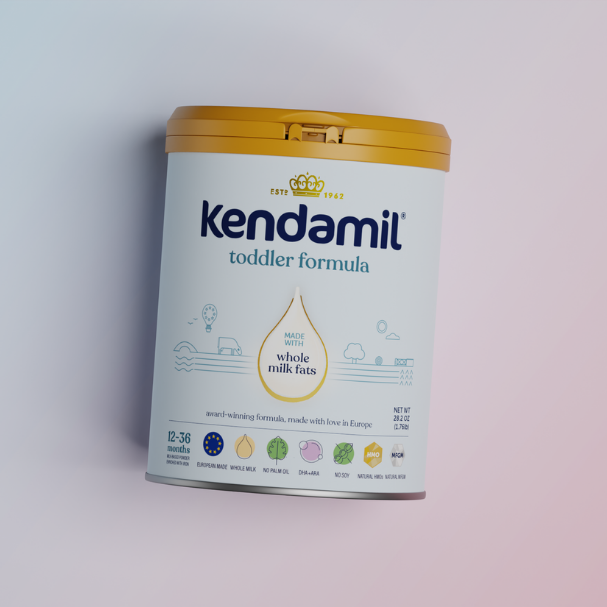From understanding how to switch baby from one formula to another, to helpful strategies for a smooth formula transition, we've got you covered. Get ready to have all your questions answered as we share our top tips for success, and address any concerns or difficulties you may come across on your formula feeding transition.
What are the signs it's time to switch my baby's formula?
Sometimes, despite our best efforts to keep our little ones content, babies can experience discomfort or react to certain ingredients in their formula. It’s common for babies to experience some digestive discomfort or feeding problems in those early days as their digestive systems mature, so might not always be linked to the formula they’re on. If you’re worried about feeding problems, check out our blog about common feeding issues and what you can do!
Just like us, babies have different taste and texture preferences, and you might find they are better suited to a different brand of formula based on taste alone! At Kendamil, we choose to use reduced levels of vegetable oils, and instead use whole milk as our main ingredient, meaning a yummy, creamier taste for your little one! We also don’t use fish oil, and instead use plant based DHA, so your baby is still getting all the important omega 3 they need, with no nasty smell or taste. You won’t find any palm oil, soy or corn syrup in our recipe, either. Our award-winning recipe is why both parents and babies LOVE our milks.
What are the different types of baby formula available?
Here at Kendamil we pride ourselves on using only high quality ingredients, which is why more than ever, parents are choosing Kendamil over other formulas or are making the switch. We’re also still one of the most affordable formulas in the US.
Check out how we compare with other US brands vs our signature recipe Kendamil Classic:
Baby formula brands comparison

Wondering which Kendamil formula to choose from?

How to switch baby formula brands
Before you dive into switching baby formula brands, it's crucial to seek the advice of healthcare professionals. Consulting with your healthcare provider ensures that any changes are tailored to your baby's individual requirements, taking into consideration their medical history and any concerns you might have. Abrupt changes can sometimes make the issue worse, rather than alleviate it. Therefore, a thoughtful and gradual transition is highly recommended to ensure your baby's well-being and comfort throughout the process. Once you've got the green light from your trusted healthcare provider, it's time to embark on the transition journey.
Baby formula transition tips:
- Best way to switch baby formula: You want to make the transition a gradual one. Abrupt changes can sometimes upset your baby's delicate digestive system. To help your little one transition and adjust to a different texture or taste, a slower phased approach can help them get used to it. You can start this by swapping one feed a day of your current formula, to your new one. Then, as each day goes on, you can swap out one extra feed. Over the course of several days to a week, continue gradually adjusting your baby's diet to include the new formula, until they are exclusively on the new brand. We’ve created a helpful chart to explain this better:

- When to switch baby formula? You don’t want to make the switch without having first spoken with your healthcare provider. There may be other issues at hand such as an allergy or another health issue not related to their formula. Explore all avenues before switching formulas.
- How long does it take to transition baby formula? It can take some babies up to a week to transition to a new formula or perhaps longer. Go at their pace and pick a time when you aren’t busy with other commitments so you can really be attentive to their needs and comfort.
Side effects of switching baby formula
All US baby formulas are made to meet the FDA’s nutritional quality and safety standards, so are safe for babies. Kendamil is both approved by the FDA and by the EU Commission, so meets both US and EU standards. So although there shouldn’t be anything too concerning when switching formulas you will want to keep a lookout for these digestive changes below.
These changes are usually temporary as your baby's digestive system adjusts to the new formula. However, if you notice any concerning symptoms or if your baby seems unusually uncomfortable, don't hesitate to reach out to your healthcare provider.
- Stool Changes: It's quite common to observe changes in your baby’s stool patterns. You might notice shifts in color, consistency, or even frequency. While it's understandable to feel a bit concerned, rest assured that this is typically a natural response as your baby's digestive system adjusts to the new formula. We understand that navigating the realm of baby poop can be a bit overwhelming, so we've prepared a helpful guide to assist you in deciphering the joys of baby poop. Find it here!
- Gas and Bloating: It's not uncommon for some babies to experience temporary bouts of gas or bloating during the transition phase to a new formula. You can lend a hand in alleviating their discomfort by trying gentle techniques such as tummy massages and bicycle leg movements. These simple yet effective methods can work wonders in providing relief.
- Spitting Up: Occasional spit-up is normal for many babies, but you may notice changes in frequency or volume during the transition period. This is typically temporary and should improve as your baby gets used to the new formula.
- Fussiness: Rest assured, it's perfectly normal for your little one to display some signs of discomfort or fussiness during the adjustment period. After all, change can be a bit unsettling for anyone, especially tiny tots! However, you can help ease their transition by showering them with soothing cuddles and affection. These comforting gestures can go a long way in helping them feel secure and content as they navigate this period of change.
Introducing Kendamil when you’re breastfeeding
Both the WHO and AAP strongly recommend exclusive breastfeeding for the first six months of an infant's life. However, some parents may want to try combination feeding, also known as mixed feeding. This involves offering both breast milk and formula to your baby. This approach can be beneficial for moms who are unable to exclusively breastfeed due to various reasons, such as returning to work, or it can be simply due to personal choice. It allows you to provide the nutritional benefits of breast milk while also ensuring that your baby receives adequate nourishment through supplementing with formula! Here are some top tips for transitioning from breastfeeding to formula feeding:
- Introducing formula: It’s just like what we’ve already spoken about, but instead of swapping brands of formula, you’re swapping for breastmilk instead! Sometimes, it can be helpful for a family member to do the first few bottle feeds, as babies have such a good sense of smell, they can sense your breastmilk! You can even mix your breastmilk and formula together.
- Maintaining your supply: When incorporating combination feeding into your routine, it's essential to continue breastfeeding or expressing milk as much as possible to preserve your milk supply. The body produces breast milk based on supply and demand, so the less you feed, the less milk your body will produce.
- Sterilization: Remember to follow proper sterilization techniques for bottles and nipples to prevent contamination and ensure your baby's safety.
- Combi feeding: For more information on combination feeding, and for help with the many common challenges that come with it, check out our blog with all the helpful information you need!
Remember, managing infant formula intolerance and adjusting your baby's diet with different formula options requires patience and persistence. Trust your instincts as a parent and don't hesitate to seek support from your healthcare provider if you have any concerns along the way. By consulting with your pediatrician, gradually transitioning, and observing your baby's digestive changes, you can ensure a happy tummy and a contented little one.
As always, if you have any questions or concerns about selecting a new baby formula or coping with formula changes, don't hesitate to reach out to our helpful customer service team, made up of parents like you! Your baby's health and well-being are our top priorities, and we're here to support you every step of the way!














